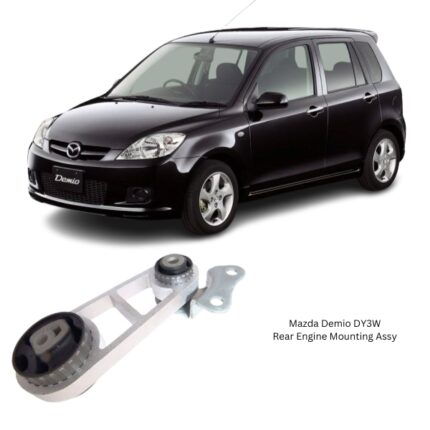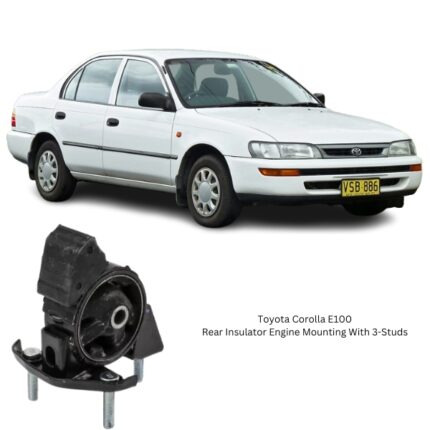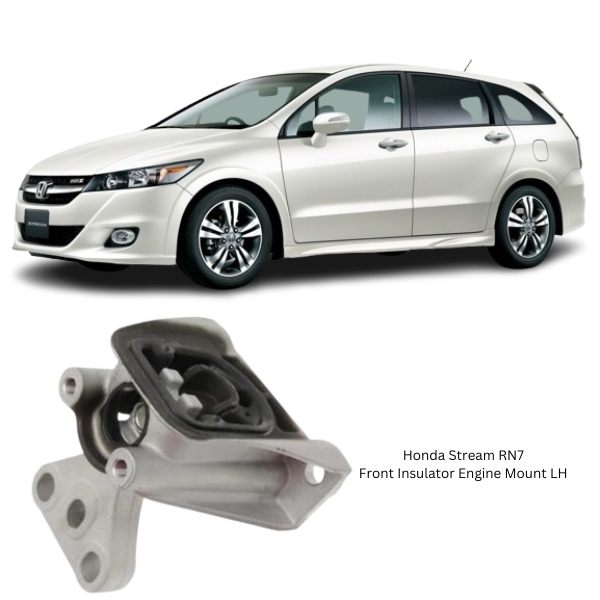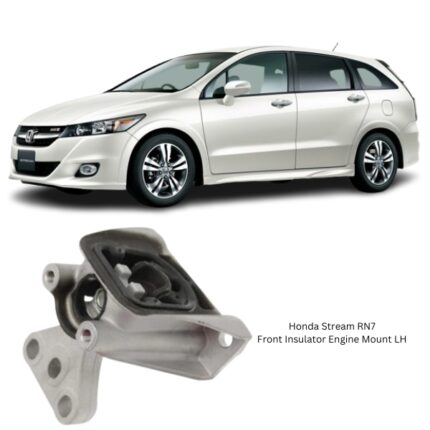Get Honda Stream RN7 Front Insulator Engine Mount LH 50850-SMA-982 in Kenya
The Front Insulator Engine Mount LH (Left-Hand Side) is a critical component in a vehicle’s engine support system. It performs a dual role: securing the engine to the chassis and isolating vibration from the engine to ensure smooth operation and enhanced comfort. Located on the left-hand side of the engine bay, this mount is specifically designed to absorb lateral (side-to-side) and torsional (twisting) forces that arise during engine operation.
As engines produce continuous movement and dynamic forces due to internal combustion, the mounts that secure them to the chassis must be robust, flexible, and capable of isolating these forces. The left-hand engine mount, particularly in front-wheel drive vehicles or those with transversely mounted engines, handles a significant share of these loads. Over time, the mount must resist vibration fatigue, temperature changes, and exposure to fluids, all while maintaining alignment and structural stability.
Function and Purpose
The Front Insulator Engine Mount LH is engineered to perform several key functions:
-
Support: Carries a portion of the engine’s weight and helps secure the engine in the correct position relative to the vehicle frame.
-
Vibration Isolation: Absorbs engine-generated vibration and prevents it from transferring into the cabin.
-
Torque Reaction Control: Dampens the rocking motion of the engine when torque loads fluctuate, especially during acceleration, braking, or gear shifts.
-
Alignment Maintenance: Keeps the engine properly aligned with drivetrain and suspension components.
-
System Protection: Reduces strain on surrounding components like hoses, wiring, exhaust manifolds, and driveshafts by minimizing unwanted engine movement.
These combined functions ensure that the engine remains stable during vehicle operation while delivering a refined driving experience.
Design and Construction
The Front Insulator Engine Mount LH is designed with durability and damping capability in mind. It consists of a structural base, a vibration-damping element, and often a metal sleeve or fluid-filled chamber to provide advanced vibration control.
Core Components:
-
Metal Bracket or Housing
Usually made from cast aluminum or stamped steel, the bracket forms the base that connects to the engine block and/or chassis. -
Elastomeric Insulator
This is the core damping element made from natural rubber or synthetic elastomer. It absorbs vibration and allows limited engine movement without transmitting harshness. -
Center Sleeve or Bushing
The center of the mount includes a metal sleeve that accepts a through-bolt. It allows the mount to be securely fastened while allowing some flex. -
Hydraulic Fluid Chamber (Optional)
Some LH mounts are hydraulic or fluid-filled, providing enhanced vibration damping, particularly for low-frequency NVH (noise, vibration, harshness) control. -
Anti-Corrosion Coating and Heat Shielding (if applicable)
Coatings protect the mount from rust and fluid damage, while heat shielding protects the rubber from nearby engine components that emit heat.
This combination of materials is selected to provide longevity, comfort, and structural support across a range of driving conditions.
Performance Characteristics
The front left-hand insulator engine mount is exposed to constant engine oscillations, acceleration forces, and external factors such as heat and road vibration. To perform effectively, it must offer the following:
-
Dynamic Load Resistance: Supports both static engine weight and dynamic movement under load.
-
Vibration Control: Isolates both low- and high-frequency vibrations to enhance driver and passenger comfort.
-
Durability: Maintains structural integrity over time despite exposure to oil, dirt, water, and temperature extremes.
-
Fatigue Resistance: Withstands repeated movement and compression without deforming or tearing.
-
Noise Reduction: Helps reduce unwanted noises that could be transmitted into the cabin.
These qualities ensure that the engine runs smoothly and stays properly secured within the engine bay.
Signs of a Failing LH Engine Mount
Like all rubber or hydraulic parts, the LH front engine mount will degrade over time due to wear and environmental conditions. Failing to replace a worn mount can lead to secondary damage in surrounding systems.
Common failure symptoms include:
-
Excessive Vibration
Increased cabin vibration, especially at idle or during acceleration, often indicates worn-out rubber or loss of hydraulic fluid. -
Clunking or Knocking Sounds
Sounds during gear changes, takeoff, or when driving over bumps can indicate that the engine is moving too much and contacting other components. -
Engine Rocking or Tilt
Visibly increased engine movement when revving or shifting gears is a classic sign of a bad mount. -
Misalignment
Poor alignment of belts, pulleys, or hoses can result from sagging engine support due to mount degradation. -
Cracked or Separated Rubber
Visual inspection may reveal torn, dry, or separated rubber, especially if contaminated by oil or heat. -
Hydraulic Fluid Leakage (in fluid-filled types)
A ruptured chamber will leak damping fluid, leading to immediate performance loss.
Addressing these symptoms promptly can prevent driveline stress, misalignment, and premature wear on transmission mounts or axle shafts.
Installation Overview
Installation of the front LH engine mount should be handled carefully to ensure safety and alignment. While specifics vary by vehicle, the general steps include:
-
Preparation
Ensure the vehicle is on a level surface. Disconnect the battery and prepare to support the engine with a jack or engine support bar. -
Access the Mount
Remove engine covers, air filters, or other obstructing components for clear access to the LH mount. -
Support the Engine
Use a floor jack (with a block of wood) under the oil pan or a top engine support brace to relieve stress from the mount. -
Remove the Old Mount
Unbolt the mount from both the engine and the chassis/frame. Remove it carefully without shifting engine position. -
Install the New Mount
Place the new LH mount in the correct orientation. Tighten bolts to manufacturer torque specifications. -
Double-Check Alignment
Ensure the engine remains level and properly aligned with other mounts. -
Reassemble and Test
Reinstall removed components, reconnect the battery, and start the engine to test for noise, vibration, or excessive movement.
Maintenance and Inspection
Though maintenance-free in operation, the LH engine mount should be inspected during routine service intervals or whenever engine vibration or knocking noises are observed.
Inspection Checklist:
-
Look for visible rubber damage or collapse
-
Check for contact between engine and chassis components
-
Inspect for signs of fluid leaks (if hydraulic)
-
Confirm proper torque on mount bolts
Routine inspections can prevent driveline issues, comfort problems, and stress-induced damage to related systems.
Benefits of Replacing a Worn LH Mount
-
Restores Smooth Engine Operation
Replacing a worn mount eliminates harshness and restores engine stability. -
Improves Cabin Comfort
Reduces noise and vibration felt through the steering wheel, pedals, and seats. -
Enhances Powertrain Longevity
Protects transmission, exhaust, and cooling systems from misalignment stress. -
Prevents Costly Repairs
Avoids damage to hoses, wiring, and structural components caused by engine misalignment or excessive rocking. -
Improves Safety
Reduces the risk of sudden engine movement or impact with chassis components.
Follow us on Facebook for more parts.





Reviews
Clear filtersThere are no reviews yet.